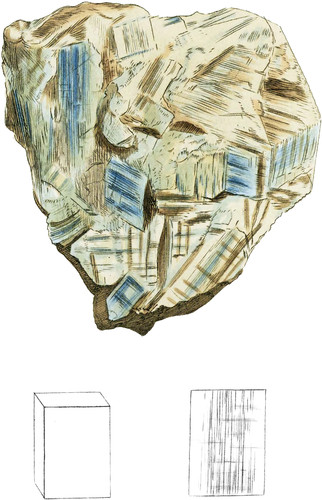 Enlarge
Enlarge
British Mineralogy
Cyanite
- Div. 1. Crystallized.
- Syn.
- Sappare. Saussure, Journal de Physique, Mars 1789. 213. Kirw. 1. 209.
- Cyanit. Emmerl. 1. 412.
- Disthène. Haüy, 3. 220.
This beautiful and curious substance is said generally to occur in primitive mountains abroad, and in Scotland. The present specimen, from near the Grampian Hills, Kincardineshire, is nearly of the best or deepest colour: few are deeper; and specimens are occasionally almost colourless. We do not approve the name of Kianite or Cyanite, taken from its colour, as it does not serve to distinguish this species from other blue minerals. The name Sappare also confounds it with Sapphire; and again, Cyanite is very similarly sounded, by some, to Sienite, which is an aggregate. We have placed this stone in the genus Argilla, to which analysis plainly shows that it belongs; and we have also made use of Cyanite as its trivial name, for it is scarcely known by any other. We have quoted a part of Haüy’s description, as most applicable to the substance. The crystals may be divided by two cuts inclined upon one another, at an angle of about 103°, one of which is much neater than the other. Spec. Grav. 3.517. A very sharp, pointed piece will scratch glass, and may be scratched by a steel point upon the large faces of its laminæ; but not upon the lateral ones. The refraction is simple. The primitive form is an oblique quadrangular prism, of which one plane is inclined upon the other, at an angle of about 103°.—Integrant molecules the same. Infusible without addition. Seldom shows any determined crystal, at least among English specimens.
| Analysis by Saussure, | by Languier. | |
|---|---|---|
| Alumina | 55 | 55.5 |
| Silica | 30 | 38.8 |
| Lime | 2 | 0.5 |
| Magnesia | 2 | |
| Oxide of Iron | 6 | 2.75 |
| Water | 0.75 | |

